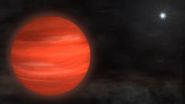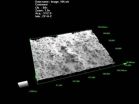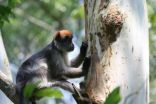(Press-News.org) Astronomers using infrared data from the Subaru Telescope in Hawaii have discovered a "super-Jupiter" around the bright star Kappa Andromedae, which now holds the record for the most massive star known to host a directly imaged planet or lightweight brown dwarf companion.
Designated Kappa Andromedae b (Kappa And b, for short), the new object has a mass about 12.8 times greater than Jupiter's. This places it teetering on the dividing line that separates the most massive planets from the lowest-mass brown dwarfs. That ambiguity is one of the object's charms, say researchers, who call it a super-Jupiter to embrace both possibilities.
"According to conventional models of planetary formation, Kappa And b falls just shy of being able to generate energy by fusion, at which point it would be considered a brown dwarf rather than a planet," said Michael McElwain, a member of the discovery team at NASA's Goddard Space Flight Center in Greenbelt, Md. "But this isn't definitive, and other considerations could nudge the object across the line into brown dwarf territory."
Massive planets slowly radiate the heat leftover from their own formation. For example, the planet Jupiter emits about twice the energy it receives from the sun. But if the object is massive enough, it's able to produce energy internally by fusing a heavy form of hydrogen called deuterium. (Stars like the sun, on the other hand, produce energy through a similar process that fuses the lighter and much more common form of hydrogen.) The theoretical mass where deuterium fusion can occur -- about 13 Jupiters -- marks the lowest possible mass for a brown dwarf.
"Kappa And b, the previously imaged planets around HR 8799 and Beta Pictoris, and the most massive planets discovered by non-imaging techniques likely all represent a class of object that formed in much the same way as lower-mass exoplanets," said lead researcher Joseph Carson, an astronomer at the College of Charleston, S.C., and the Max Planck Institute for Astronomy in Heidelberg, Germany.
The discovery of Kappa And b also allows astronomers to explore another theoretical limit. Astronomers have argued that large stars likely produce large planets, but experts predict that this stellar scaling can only extend so far, perhaps to stars with just a few times the sun's mass. The more massive a young star is, the brighter and hotter it becomes, resulting in powerful radiation that could disrupt the formation of planets within a circumstellar disk of gas and dust.
"This object demonstrates that stars as large as Kappa And, with 2.5 times the sun's mass, remain fully capable of producing planets," Carson adds.
The research is part of the Strategic Explorations of Exoplanets and Disks with Subaru (SEEDS), a five-year effort to directly image extrasolar planets and protoplanetary disks around several hundred nearby stars using the Subaru Telescope on Mauna Kea, Hawaii. Direct imaging of exoplanets is rare because the dim objects are usually lost in the star's brilliant glare. The SEEDS project images at near-infrared wavelengths using the telescope's adaptive optics system, which compensates for the smearing effects of Earth's atmosphere, in concert with its High Contrast Instrument for the Subaru Next Generation Adaptive Optics and Infrared Camera and Spectrograph.
Young star systems are attractive targets for direct exoplanet imaging because young planets have not been around long enough to lose much of the heat from their formation, which enhances their brightness in the infrared. The team focused on the star Kappa And because of its relative youth -- estimated at the tender age of 30 million years, or just 0.7 percent the age of our solar system, based on its likely membership in a stellar group known as the Columba Association. The B9-type star is located 170 light-years away in the direction of the constellation Andromeda and is visible to the unaided eye.
Kappa And b orbits its star at a projected distance of 55 times Earth's average distance from the sun and about 1.8 times as far as Neptune; the actual distance depends on how the system is oriented to our line of sight, which is not precisely known. The object has a temperature of about 2,600 degrees Fahrenheit (1,400 Celsius) and would appear bright red if seen up close by the human eye.
Carson's team detected the object in independent observations at four different infrared wavelengths in January and July of this year. Comparing the two images taken half a year apart showed that Kappa And b exhibits the same motion across the sky as its host star, which proves that the two objects are gravitationally bound and traveling together through space. Comparing the brightness of the super-Jupiter between different wavelengths revealed infrared colors similar to those observed in the handful of other gas giant planets successfully imaged around stars.
A paper describing the results has been accepted for publication in The Astrophysical Journal Letters and will appear in a future issue.
The SEEDS research team is continuing to study Kappa And b to better understand the chemistry of its atmosphere, constrain its orbit, and search for possible secondary planets.
Coincidentally, the stellar association that hosts Kappa And also includes another famous high-mass star, HR 8799, which is one of the first where astronomers directly imaged an extrasolar planet. The system hosts several gas giant planets with masses and infrared colors similar to Kappa And b.
INFORMATION:
Astronomers directly image massive star's 'super-Jupiter'
2012-11-20
ELSE PRESS RELEASES FROM THIS DATE:
Ah, that new car smell: NASA technology protects spacecraft from outgassed molecular contaminants
2012-11-20
Outgassing — the physical process that creates that oh-so-alluring new car smell — isn't healthy for humans and, as it turns out, not particularly wholesome for sensitive satellite instruments, either. But a team of NASA engineers has created a new way to protect those instruments from its ill effects.
For some people, the best part about buying a new car is its factory-fresh new car smell, a distinctive aroma created when the chemicals and residual solvents used to manufacture dashboards, car seats, carpeting and other vehicle appointments outgas and fill the cabin. ...
Some cells don't know when to stop
2012-11-20
Certain mutated cells keep trying to replicate their DNA — with disastrous results — even after medications rob them of the raw materials to do so, according to new research from USC.
New imaging techniques allowed scientists to see for the first time that while chemotherapy drugs shut down the DNA replication process of most cancer cells, so-called "checkpoint mutants" just keep chugging along, unwinding the DNA and creating damaged DNA strands that can result in the kind of abnormalities seen in cancer cells.
"Older methods suggested that these checkpoint mutants ...
NASA sees sun's 2 Prominence Eruptions
2012-11-20
VIDEO:
The Sun erupted with two prominence eruptions, one after the other over a four-hour period (Nov. 16, 2012). The action was captured in the 304 Angstrom wavelength of extreme ultraviolet...
Click here for more information.
The Sun erupted with two prominence eruptions, one after the other over a four-hour period on Nov. 16, 2012, between the hours of 1 and 5 a.m. EST. The red-glowing looped material is plasma, a hot gas made of electrically charged hydrogen and helium. ...
Beargrass, a plant of many roles, is focus of new report
2012-11-20
Beargrass is an ecologically, culturally, and economically important plant in the Western United States and, for the first time, landowners, managers, and harvesters now have a comprehensive report about the species.
The report, Natural and Cultural History of Beargrass (Xerophyllum tenax), published by the U.S. Forest Service's Pacific Northwest Research Station, identifies critical knowledge gaps and areas for future research. It also documents how changes in disturbance, including fire, may affect the species across its range.
"Beargrass is emblematic of a web of ...
Estrogenic plants linked to altered hormones, possible behavior changes in monkeys
2012-11-20
Berkeley — Eating certain veggies not only supplies key nutrients, it may also influence hormone levels and behaviors such as aggression and sexual activity, says a new study led by researchers at the University of California, Berkeley, that could shed light on the role of diet in human evolution.
The research is the first to observe the connection between plant-based estrogenic compounds, or phytoestrogens, and behavior in wild primates — in this case, a group of red colobus monkeys in Uganda.
The more the male monkeys dined on the leaves of Millettia dura, a tropical ...
Adolescents with low status among peers are more likely to become adult smokers
2012-11-20
A new study from Sweden reveals that having low peer status in adolescence is a strong risk factor for regular and heavy smoking in adulthood.
Researchers from Stockholm University in Sweden used a large database that followed the lives of more than 15,000 Swedes, mainly from the Stockholm area, from birth to middle age. The researchers isolated 2,329 people who were interviewed once at age 13 about peer status at school and again at age 32 about their smoking habits. The results indicate that the lower a young person's status is among his or her school peers, the more ...
Novel breast screening technology increases diagnostic accuracy
2012-11-20
OAK BROOK, Ill. – The addition of three-dimensional breast imaging—a technology called tomosynthesis—to standard digital mammography significantly increases radiologists' diagnostic accuracy while reducing false positive recall rates, according to the results of a multi-center study published in Radiology.
"This is the first major advance in breast imaging and breast cancer screening since the development of breast MRI," said lead researcher Elizabeth A. Rafferty, M.D., director of Breast Imaging at the Avon Comprehensive Breast Center at Massachusetts General Hospital ...
New coronavirus related to viruses from bats
2012-11-20
The virus that is causing alarm among global public health authorities after it killed a man in Jeddah, Saudi Arabia earlier this year and is now linked to two other cases of disease is a novel type of coronavirus most closely related to viruses found in bats, according to a genetic analysis to be published in mBio®, the online open-access journal of the American Society for Microbiology, on November 20. Researchers studied the genome of the HCoV-EMC/2012 virus in detail to learn about its relatedness to other viruses and about possible sources. The results of the sequencing ...
Rate of suicide by hanging/suffocation doubles in middle-aged men and women
2012-11-20
A new report from researchers with the Johns Hopkins Center for Injury Research and Policy finds the majority of the previously reported increase in suicide in the U.S. between 2000 and 2010 is attributable to an increase in hanging/suffocation, which increased from 19 percent of all suicides in 2000 to 26 percent of all suicides in 2010. The largest increase in hanging/suffocation occurred among those aged 45-59 years (104 percent increase). The results are published in the December issue of the American Journal of Preventive Medicine.
"Suicide recently exceeded motor ...
Lion'esque Style Opens Holiday Pop Up Shop
2012-11-20
Just in time for the holiday season, LionesqueStyle.com curates its first experience store connecting women with a unique shopping destination.
Online retailer LionesqueStyle.com will open its first NYC storefront for the holidays at "The Corner" in the Roger Smith hotel. Inspired by years of curating pop-up shops in NYC, the Hamptons and LA, CEO Melissa Gonzalez founded Lion'esqueStyle.com to create a one-stop-online store where shoppers can virtually meet the next "it" brand and stay ahead of the fashion trends. As curators, LionesqueStyle.com is ...


